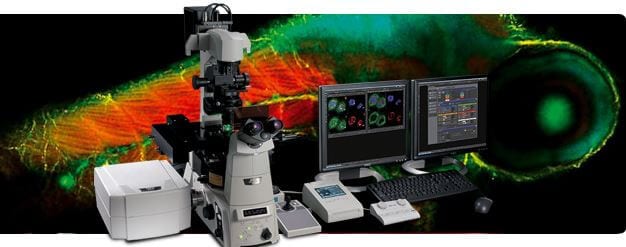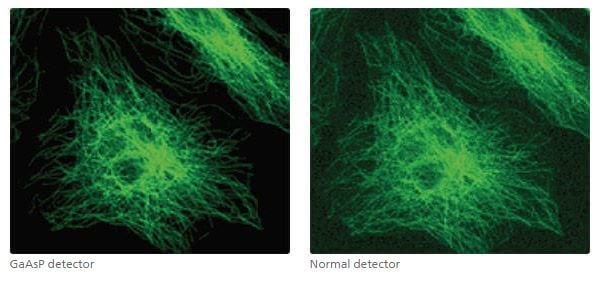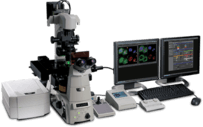


Scanning Confocal Microscope – Bring imaging to life: high-speed, high-resolution confocal imaging.
Capturing high-quality 3d confocal images at ultrahigh-speed and enhanced sensitivity with a resonant scanner and galvano scanner, Nikon’s A1R+ is a powerful tool for the imaging and visualization of intracellular dynamics and interaction.
ER: Enhance Your 3d Confocal Resolution
The A1 ER enhanced resolution Module combines powerful GPU-based processing and specialized deconvolution algorithms to dramatically enhance the spatial resolution of your A1+ or A1R+ confocal microscope with minimal processing time.
The A1 ER Module provides high quality PSF models for Nikon’s high performance objective lenses, taking the guesswork out of deconvolution analysis. Other features include automatic or manual mode for iteration selection, enhanced spherical aberration correction, and robust algorithms for noise estimation and removal.
Revolutionary Hybrid Confocal Scan Head
The A1R+ has a hybrid laser scanner head that incorporates both an ultrahigh-speed resonant scanner and a high-resolution galvano scanner. Simultaneous photoactivation and ultrafast imaging using these two scanners allow acquisition of rapid changes after photoactivation and enables observation of intermolecular interaction.
Resonant Scanner Provides Ultrafast Imaging
The A1R+ resonant scanner has an ultrahigh resonance frequency of 7.8 kHz. It allows imaging of intercellular dynamics at 30 fps (512 x 512 pixels) and 420 fps (512 x 32 pixels), the world’s fastest image acquisition. The field of view of the scanned area is approximately five times larger than that of the galvano scanner. The Nikon original optical clock generation method realizes high image quality even at the highest speed. The fiber-optic communication data transfer system can transfer data at a maximum of 4Gbps.
Galvano Scanner Enables High-resolution Imaging
The A1+ utilizes a galvano scanner which enables high-resolution imaging of up to 4096 x 4096 pixels. In addition, with the newly developed scanner driving and sampling systems, plus image correction technology, high-speed acquisition of 10 fps (512 x 512 pixels) is also possible.
GaAsP Multi Detector Unit
Nikon developed the GaAsP multi-detector unit equipped with two GaAsP PMTs and two normal PMTs.
A GaAsP PMT has much higher sensitivity than a normal PMT, thus acquisition of brighter signals with minimal background noise is possible with a GaAsP PMT, even with weak fluorescence, which, until now, has been difficult to detect.
When using resonant scanners, the GaAsP PMT enables low-noise, high-speed imaging.
Increased Light Detection Efficiency
The low-angle incidence method utilized on the dichroic mirrors increases fluorescence efficiency by 30%.
| Conventional 45° incidence angle method |
By employing the hexagonal pinhole, higher brightness equivalent to that of a circular pinhole is achieved.
|
64% of the area of the circle |
30% more light |
83% of the area of the circle
Nikon’s original dual integration signal processing technology (DISP) has been implemented in the image processing circuitry to improve electrical efficiency, resulting in an extremely high S/N ratio.
Enhanced Spectral Imaging
Acquisition of a 32-channel spectral image (512 x 512 pixels) with a single scan in 0.6 second is possible. Moreover, 512 x 32-pixel images can be captured at 24 fps.
Accurate, High-speed Unmixing
Accurate spectral unmixing provides maximum performance in the separation of closely overlapping fluorescence spectra and the elimination of autofluorescence. Superior algorithms and high-speed data processing enable real time unmixing during image acquisition.
V-filtering Function
Filter-less intensity adjustment is possible by selecting desired spectral ranges from 32 channels that match the spectrum of the fluorescence probe in use and combining them to perform the filtering function.
NIS-Elements C control software enables integrated control of the confocal imaging system, microscope and peripheral devices with a simple and intuitive interface. Diverse reliable analysis functions are also available.
Combine with Super-Resolution Modalities
Multi-mode imaging is possible by equipping the A1R+ with Nikon’s N-SIM E or N-STORM 4.0 super-resolution system. Combining confocal and super-resolution modalities on the same microscope enables users to easily compare and verify super-resolution data with traditional confocal images. In addition, users can take full advantage of the confocal imaging modality to acquire contextual information for their super-resolution images.
| Scan head input/output port | 2 laser input ports 3 signal output ports for standard, spectral and optional detector*1 | |
|---|---|---|
| Laser | LU-N3 3-laser unit | 405 nm, 488 nm, 561nm lasers are installed ; built-in AOTF *Cannot be used with spectral detector |
| LU-N4/LU-N4S 4-laser unit |
405 nm, 488 nm, 561nm,640nm laser are installed;built-in AOTF *Use LU-N4S when using the spectral detector | |
| LU-NV series laser unit | Compatible lasers : 405 nm, 445 nm, 458nm,488nm,514nm,532nm,561nm,594nm,640nm,647nm ; built-in AOTF | |
| Standard fluorescence detector | Wavelength | 400-750 nm |
| Detector | A1-DU4 4 Detector Unit: 4 standard PMTs A1-DUG GaAsP Multi Detector Unit: 2 GaAsP PMTs + 2 standard PMTs | |
| Filter cube | 6 filter cubes commonly used for a microscope mountable on each of three filter wheels Recommended wavelengths: 450/50, 482/35, 515/30, 525/50, 540/30, 550/49, 585/65, 595/50, 700/75 | |
| Diascopic detector (option) | Wavelength | 485-650 nm |
| Detector | PMT | |
| FOV | Square inscribed in a ø18 mm circle | |
| Image bit depth | 4096 gray intensity levels (12 bit) | |
| Scan head | Standard image acquisition | Scanner: galvano scanner x2 Pixel size: max. 4096 x 4096 pixels Scanning speed: Standard mode: 2 fps (512 x 512 pixels, bi-direction), 24 fps (512 x 32 pixels, bi-direction) Fast mode: 10 fps (512 x 512 pixels, bi-direction), 130 fps (512 x 32 pixels, bi-direction)*2 Zoom: 1-1000x continuously variable Scanning mode: X-Y, X-T, X-Z, XY rotation, Free line |
| High-speed image acquisition | Scanner: resonant scanner (X-axis, resonance frequency 7.8 KHz), galvano scanner (Y-axis) Pixel size: max. 512 x 512 pixels Scanning speed: 30 fps (512 x 512 pixels) to 420 fps (512 x 32 pixels), 15,600 lines/sec (line speed) Zoom: 7 steps (1x, 1.5x, 2x, 3x, 4x, 6x, 8x) Scanning mode: X-Y, X-T, X-Z Acquisition method: Standard image acquisition, High-speed image acquisition, Simultaneous photoactivation and image acquisition | |
| Dichroic mirror | Low-angle incidence method, Position: 8 Standard filter: 405/488, 405/488/561, 405/488/561/638, 405/488/543/638, 457/514, BS20/80 Optional filter: 457/514/561 | |
| Pinhole | 12-256 µm variable (1st image plane) | |
| Spectral detector*3 (option) |
Number of channels | 32 channels |
| Wavelength detection range | 400-750 nm | |
| Spectral image acquisition speed | 4 fps (256 x 256 pixels), 1000 lps Pixel size: max. 2048 x 2048 | |
| Wavelength resolution | 80 nm (2.5 nm), 192 nm (6 nm), 320 nm (10 nm) Wavelength range variable in 0.25 nm steps | |
| Unmixing | High-speed unmixing, Precision unmixing | |
| Z step | Ti-E: 0.025 µm, FN1 stepping motor: 0.05 µm Ni-E: 0.025 µm | |
| Compatible microscopes | ECLIPSE Ti-E inverted microscope, ECLIPSE FN1 fixed stage microscope, ECLIPSE Ni-E upright microscope (focusing nosepiece type and focusing stage type) | |
| Option | Motorized XY stage (for Ti-E/Ni-E), High-speed Z stage (for Ti-E), High-speed piezo objective-positioning system (for FN1/Ni-E) | |
| Software | Display/image generation | 2D analysis, 3D volume rendering/orthogonal, 4D analysis, spectral unmixing |
| Image format | JP2, JPG, TIFF, BMP, GIF, PNG, ND2, JFF, JTF, AVI, ICS/IDS | |
| Application | FRAP, FLIP, FRET(option), photoactivation, three-dimensional time-lapse imaging, multipoint time-lapse imaging, colocalization | |
| Control computer | OS | Microsoft Windows® 7 Professional 64bits SP1 |
| CPU | Intel Xeon E5-2643v3 (3.40 GHz/20 MB) or higher | |
| Memory | 16 GB or higher | |
| Hard disk | 300 GB SAS (15,000 rpm) x2, RAID 0 configuration | |
| Data transfer | Dedicated data transfer I/F | |
| Network interface | 10/100/1000 Gigabit Ethernet x2 | |
| Monitor | 1600 x 1200 or higher resolution, dual monitor configuration recommended | |
| Recommended installation conditions | Temperature 23 ± 5 ºC, humidity 70 % (RH) or less (non-condensing) | |
* 1 FCS/FCCS/FLIM is possible in combination with third-party systems
* 2 Fast mode is compatible with zoom 8-1000x and scanning modes X-Y and X-T. It is not compatible with Rotation, Free line, CROP, ROI, Spectral imaging, Stimulation and FLIM.
* 3 Compatible with galvano scanner only.
 Bioengineering
Bioengineering Biomechanics
Biomechanics Biophysics
Biophysics Cardiovascular Research
Cardiovascular Research Cell Biology
Cell Biology Developmental Biology/Embryology
Developmental Biology/Embryology Endocrinology
Endocrinology Food Science
Food Science Hepatology
Hepatology Molecular Biology
Molecular Biology Nephrology
Nephrology Neurobiology / Neuroscience
Neurobiology / Neuroscience Obstetrics & Gynaecology
Obstetrics & Gynaecology Odontology (dentistry)
Odontology (dentistry) Oncology
Oncology Ophthalmology
Ophthalmology Orthopaedics
Orthopaedics Osteology
Osteology Pathology
Pathology Pharmaceutical Sciences
Pharmaceutical Sciences Rheumatology
Rheumatology Stem Cell & Regenerative Medicine
Stem Cell & Regenerative Medicine Tropical Medicine
Tropical Medicine Urology
Urology Vascular Research
Vascular Research